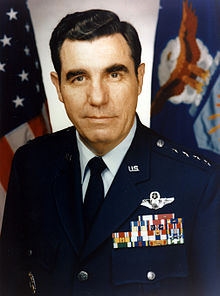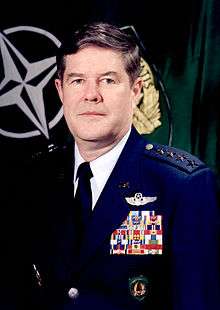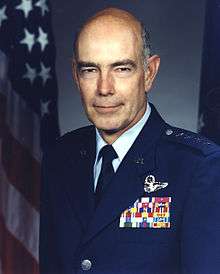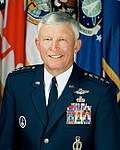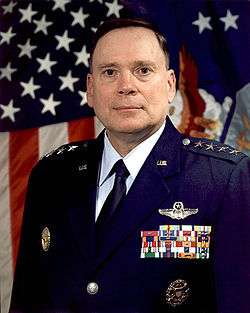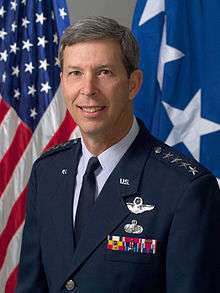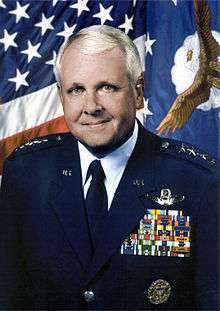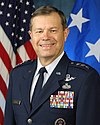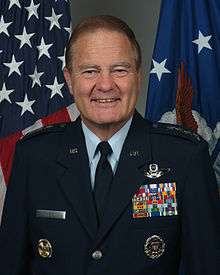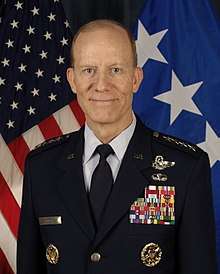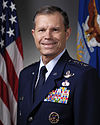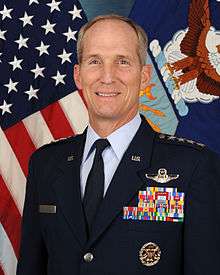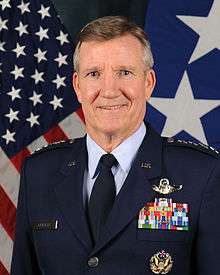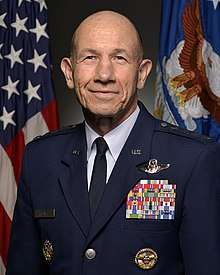Air Combat Command
Air Combat Command (ACC) is one of nine Major Commands (MAJCOMs) in the United States Air Force, reporting to Headquarters, United States Air Force (HAF) at the Pentagon.[9] It is the primary provider of air combat forces for the Air Force, and it is the direct successor to Tactical Air Command. Air Combat Command is headquartered at Langley Air Force Base, Joint Base Langley–Eustis, Virginia, United States.
| Air Combat Command | |
|---|---|
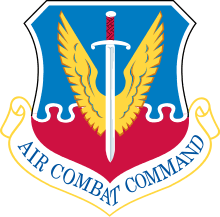 Shield of Air Combat Command | |
| Active | 21 March 1946 – present (74 years, 4 months) Detailed
|
| Country | |
| Branch | |
| Type | Major Command |
| Role | Train, equip, and provide air combat forces[3] |
| Size | 84,850 Airmen 1,110 aircraft[4] |
| Headquarters | Langley Air Force Base, Joint Base Langley–Eustis, Virginia, U.S. |
| Motto(s) | "Global Power for America."[5] |
| Engagements | Operation Urgent Fury[2] |
| Decorations | Air Force Organization Excellence Award[2] |
| Website | acc.af.mil |
| Commanders | |
| Commander | Gen James M. Holmes[6] |
| Deputy Commander | Lt Gen Christopher P. Weggeman[6] |
| Command Chief | CCM David W. Wade[6] |
| Aircraft flown | |
| Attack | A-10C, AC-130U, MQ-1, MQ-9 |
| Bomber | B-1B, B-2A, B-52H[4] |
| Electronic warfare | E-3B/C/G, E-8C, E-9A, E-11A, EC-130H |
| Fighter | F-15C/D, F-15E, F-16C/D, F-22A, F-35A |
| Multirole helicopter | HH-60G |
| Reconnaissance | MC-12, OC-135B, RC-26B, RC-135S/U/V/W, RQ-4, RQ-170, U-2S, U-28A, WC-135 |
| Trainer | T-38A, TC-135S/W, QF-4, QF-16 |
| Transport | C-17A, C-130J[7] |
| Tanker | HC-130N/P/J, KC-135R, MC-130 |
| LGM-30G[8] | |
Mission
The mission of Air Combat Command is to be the primary force provider of air combat forces to America's warfighting commands, the geographic Unified Combatant Commands, specifically to United States Central Command, United States Southern Command, and United States Northern Command, where ACC Numbered Air Forces serve as the air components. In addition, ACC augments the forces of the United States European Command, United States Africa Command, United States Pacific Command, and United States Strategic Command. ACC organizes, trains, equips, and maintains combat-ready units for rapid deployment abroad while also ensuring air defense of the United States is strong enough for both peacetime and wartime needs.
ACC directly operates 1,110 fighter, attack, reconnaissance, combat search and rescue, airborne command and control and electronic aircraft along with command, control, computing, communications and intelligence (C4I) systems, Air Force ground forces, conducts global information operations, and controls Air Force Intelligence.[10]
Air Combat Command consists of approximately 74,240 active duty Airmen and 10,610 Department of the Air Force Civilians. When mobilized, more than 49,000 additional Airmen of the Air Force Reserve and the Air National Guard, along with over 700 additional aircraft, are operationally-gained and assigned to ACC, bringing total aircraft to more than 1,800 and number of Airmen to 123,240.[4]
In 2009, responsibility for nuclear-capable bombers, specifically the B-2 Spirit and the B-52 Stratofortress, along with their associated units, bases and personnel, were transferred from ACC to the newly established Air Force Global Strike Command (AFGSC). In 2015, responsibility for the B-1 Lancer bomber fleet was also transferred from ACC to AFGSC, putting the entire Air Force bomber force under AFGSC, however some B-1Bs and B-52Hs remain under the 53d Wing for test and evaluation.[11]
History
Air Combat Command was created 1 June 1992 after the inactivation of the Tactical Air Command (TAC), Strategic Air Command (SAC) and Military Airlift Command (MAC). Upon activation, ACC assumed control of all former-TAC fighters, all bombers, reconnaissance platforms, battle management resources, and Intercontinental ballistic missiles (ICBMs). Furthermore, ACC had some KC-135 and KC-10 aerial refueling tankers and C-130 tactical airlift aircraft in its composite, reconnaissance, and other combat wings. In 1993, control of the ICBM force was transferred to the Air Force Space Command (AFSPC) until transferred again to Air Force Global Strike Command (AFGSC) on 1 December 2009.[12]
Following the inactivation of SAC at Offutt AFB, Nebraska, a new unified command, the United States Strategic Command, was activated at Offutt, created to manage the combined strategic nuclear forces belonging to both the U.S. Air Force and the U.S. Navy.[12]
Historically, Combat Command was an earlier air unit designation. During 1941 and early 1942, the tactical air units of the War Department, formerly known as the GHQ Air Force, formed the Air Force Combat Command. The AFCC was dissolved in the reorganization of the United States Army, effective 9 March 1942, which created the United States Army Air Forces as a major command of the Army, which functioned as a de facto independent service branch of the Armed Forces.[12]
Mission Realignments
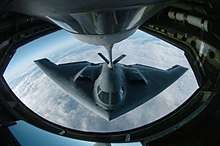
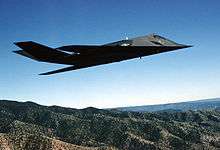
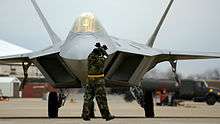
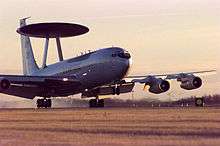
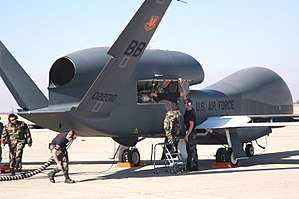
Combat search and rescue
Not long after activation, ACC underwent organizational and mission changes. The first such major change was the transfer of the combat search and rescue mission (CSAR) from Air Mobility Command to ACC. With the realigning of search and rescue units, ACC gained additional resources, as well as a new mission. The formal transfer took place on 1 February 1993, when the Air Rescue Service (ARS) was assigned to ACC. On 2 July of the same year, the ARS was disestablished and rescue units became fully integrated in the same manner as other ACC units reporting to numbered air forces. The USAF Combat Rescue School was subsequently assigned to the 57th Wing at Nellis AFB, Nevada.[12]
Flight training
One of the most significant changes for Air Combat Command resulted from an overhaul of flying training responsibilities. Following its activation, ACC was responsible for aircraft-specific aircrew training, including initial weapon system and continuation training. On 1 July 1993, the 58th and 325th Fighter Wings—F-16 and F-15 training units transferred from ACC to Air Education and Training Command (AETC). Concurrently, Luke AFB, Arizona, and Tyndall AFB, Florida, for which those respective wings were the host units, also moved from ACC to AETC ownership. However, on 1 October 2012, both Tyndall AFB and the 325th Fighter Wing returned to the control of ACC.[12]
Tanker and airlift
The next major organizational change resulted from a fine-tuning of aerial refueling and airlift resources. From its activation, Air Combat Command had assumed ownership of some C-130 Hercules theater airlift assets and KC-10 Extender and KC-135 Stratotankers. Just as ownership of overseas C-130 resources had already been transferred to USAFE and PACAF commanders, it was decided that all C-130s based in the CONUS would be under the control of ACC, while at the same time, almost all KC-135 tankers would be assigned to Air Mobility Command.[12]
There was historical precedent for the reassignment of C-130s to Air Combat Command. During the earliest days of Tactical Air Command (TAC), the command had carried out the "tactical" or combat airborne aspect of airlift operations, leaving the "strategic" or logistical mission to Military Air Transport Service, later redesignated Military Airlift Command (the precursor of today's Air Mobility Command) in 1966. The tactical airlift mission included logistical airlift, airborne operations, aeromedical evacuation, and air support for special operations. This division of the airlift mission continued until 1 December 1974, when TAC transferred its CONUS-based tactical airlift units, including Air Force Reserve and Air National Guard tactical airlift units, to Military Airlift Command (MAC). MAC gained the overseas units from theater commands on 31 March 1975.[12]
On 1 October 1993, all Air Mobility Command C-130s with the exception of those permanently under United States Air Forces in Europe (USAFE) and Pacific Air Forces (PACAF) regions were transferred to ACC, while USAFE and PACAF assumed control of the C-130 permanently based in their respective geographic regions. Concurrently, all KC-10 tankers and all KC-135 tankers except those at Mountain Home AFB, Idaho, which supported the fighter and bomber aircraft of the composite wing stationed there, transferred to AMC. ACC also retained two KC-135s at Offutt AFB Nebraska and Grand Forks AFB, North Dakota under ACC control until transferring them to AMC on 1 October 1993. McConnell AFB, Kansas; Fairchild AFB, Washington; and their respective air refueling wings were also transferred to AMC in January 1994 and July 1994, respectively.[12]
In 1997, a subsequent USAF reorganization of ACC and AMC resulted in all CONUS-based C-130 theater airlift aircraft being reassigned from ACC back to AMC. This change also shifted operational claimancy for all "slick" theater airlift mission C-130s in the Air Force Reserve and CONUS-based Air National Guard. USAFE and PACAF C-130 assets remained in those respective MAJCOMs to include PACAF's operational claimancy for Alaska Air National Guard C-130 and HC-130 assets.[13]
Operational deployments
In Southwest Asia, Air Combat Command provided active duty and reserve component forces for the follow-on to Operation Desert Storm and the establishment of Operation Southern Watch to deter Iraqi aggression. In October 1994, ACC also demonstrated its ability to react quickly to the buildup of Iraqi troops near the border of Kuwait. In addition, ACC, from its inception, has provided indispensable support to counter-drug operations, including Airborne Warning and Control System (AWACS), reconnaissance and fighter aircraft, as well as radar and connectivity assets.[12]
Participation in humanitarian operations has also been a recurring theme. Air Combat Command supported the humanitarian efforts of the United States Air Forces in Europe (USAFE), deploying active duty and air reserve component forces to Provide Promise and Deny Flight in Eastern Europe and Operation Provide Comfort out of Incirlik AB, Turkey. Provide Promise offered humanitarian relief airlift support to the city of Sarajevo, while Deny Flight enforced the "no-fly" zone against Serb air attacks on Bosnian civilians. Operation Provide Comfort, another humanitarian operation, also provided relief to Kurdish inhabitants of northern Iraq who had undergone fierce repression by the Iraqi government.[12]
In addition, ACC supported United States Atlantic Command's humanitarian relief to Haitian refugees associated with Operation GTMO at Guantanamo Bay Naval Base, Cuba. Similarly, the command supported Operation Safe Haven and the processing of Cuban refugees during the latter part of the summer of 1994. Across the Atlantic, Air Combat Command units participated in Operation Restore Hope, largely an Air Mobility Command humanitarian operation intended to provide food for Somalia. Also, ACC regular and ACC-gained Air National Guard C-130 units deployed to Uganda and Kenya to participate in Operation Support Hope. This operation, conducted by the United States European Command, comprised part of the United Nations effort to provide humanitarian relief to victims of the civil war in Rwanda.[12]
In keeping with its global responsibilities, ACC initiated a series of "Global Power" missions in 1993. ACC's bomber wings are required to perform out-of-CONUS training flights to demonstrate the capability to perform their "quick reaction" worldwide mission. On one of the global power missions, two B-1 Lancer aircraft of the 28th Bomb Wing, Ellsworth AFB, South Dakota, set a B-1 flying time record on the first leg of their round-the-world flight, 11–13 August 1993. The following year, two B-52s from the 2d Bomb Wing, Barksdale AFB, Louisiana, circumnavigated the globe in 47.2 hours, the longest jet aircraft flight in history.[12]
Global war on terrorism
Air Combat Command units flew operational missions during the 2002 Operation Enduring Freedom – Afghanistan (OEF-A) and the 2003 invasion of Iraq, Operation Iraqi Freedom.
The task of developing a comprehensive listing of ACC units present in Iraq, Afghanistan and other combat areas is particularly difficult as the events of 11 September 2001 and the Global War on Terrorism has made such an effort significantly difficult. The USAF seeks to improve operational security (OPSEC) and to deceive potential enemies as to the extent of American operations, therefore a listing of which units deploying where and when is unavailable.[12]
However, it is certain that ACC units are actively flying combat missions in the Southwest Asia theater of operations.
Predecessor units merged into Air Combat Command 1992
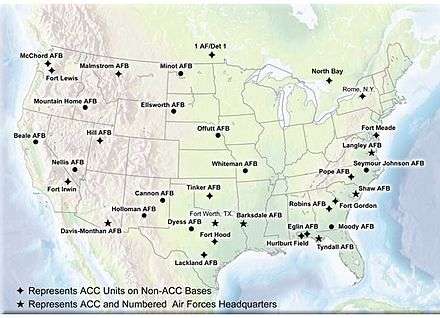
|
|
Wings and groups
As of 2016, Air Combat Command consisted of the following units:[9]
|
|
On 1 February 2010, the Eighth Air Force transferred to the Air Force Global Strike Command. The 7th Bomb Wing at Dyess Air Force Base, and the 28th Bomb Wing at Ellsworth Air Force Base also transferred to AFGSC on 1 October 2015, thus, ending 23 years of operational bomber service in ACC.
It was announced in September 2019 that Twenty-Fourth Air Force and Twenty-Fifth Air Force would be merged into an information warfare air force numbered as Sixteenth Air Force and Maj. Gen. Timothy Haugh would be nominated as a lieutenant general to lead this numbered air force. This new Sixteenth Air Force headquarters will be based in San Antonio, Texas.[17]
In addition, units from Air Force Reserve Command's Tenth Air Force, and numerous other state and District of Columbia Air National Guard units are allocated to Air Combat Command when activated to federal service.
Aircraft
As of 2015:
|
|
Lineage
- Constituted as Air Combat Command and activated on 1 June 1992
- Consolidated with Tactical Air Command on 26 September 2016[18]
Assignments
- Headquarters, United States Air Force, 1 June 1992 – present
Stations
- Langley Air Force Base, Hampton, Virginia, 1 June 1992 – present[19]
Major components
- Air Forces
- First Air Force: 1 June 1992 – present
- Second Air Force: 1 June 1992 – 1 July 1993
- Transferred to Air Education and Training Command
- Eighth Air Force: 1 June 1992 – 2009
- Transferred to Air Force Global Strike Command, 2009
- Ninth Air Force: 1 June 1992 – present
- Twelfth Air Force: 1 June 1992 – present
- Sixteenth Air Force: 11 October 2019 – present
- Twentieth Air Force: 1 June 1992 – 1 July 1993
- Transferred to Air Force Space Command, 1993
- Transferred to Air Force Global Strike Command, 2009
- Twenty-Fourth Air Force: 17 July 2018 – 11 October 2019
- Twenty-Fifth Air Force: 29 September 2014 – 11 October 2019
- Centers
- Air & Space Expeditionary Force Center: 1 October 2002 – 29 August 2006
- Aerospace Command and Control & Intelligence, Surveillance and Reconnaissance (later, Air Force Command and Control & Intelligence, Surveillance and Reconnaissance) Center (see Agencies below): 29 July 1997 – 30 April 2002. On 17 June 2010, the GCIC was officially redesignated the Air Force Command and Control Integration Center or AFC2IC as a direct reporting unit to Air Combat Command (ACC).[20]
- Air Force Contingency Supply Support Office (later, Air Force Contingency Supply Squadron; ACC Regional Supply Squadron; Combat Air Forces Logistics Support Center): 12 June 1992 – 1 July 1994; 1 December 1998 – present
- Air Warfare Center, later renamed the USAF Warfare Center: 1 June 1992 – present
- Air Force Network Integration Center: 17 July 2018 – present
- Air Force Spectrum Management Office: 17 July 2018 – present
- Agencies
- Air and Space Command and Control Agency (later, Aerospace Command and Control Agency; Aerospace Command and Control & Intelligence, Surveillance and Reconnaissance Center; Air Force Command and Control & Intelligence, Surveillance and Reconnaissance Center): 29 July 1997 – 30 April 2002.
- Air Intelligence Agency: 1 February 2001 – 8 August 2006
- Groups
- Air Combat Command (ACC) Air Force Targeting Center: 2008–present
- Air Combat Command (ACC) Communications Group: 1 June 1992 – present
- Air Combat Command (ACC) Logistics Support Group: 1 July 1994 – 16 September 1999.
source for lineage, assignments, stations, components[21]
Commanders of Air Combat Command (COMACC)
| No. | Commander | Term | |||
|---|---|---|---|---|---|
| Portrait | Name | Took office | Left office | Term length | |
| 1 | General John M. Loh | 1 June 1992 | 23 June 1995 | 3 years, 22 days | |
| 2 | General Joseph Ralston | 23 June 1995 | 28 February 1996 | 250 days | |
| - | Lieutenant General Brett M. Dula Acting | 28 February 1996 | 5 April 1996 | 37 days | |
| 3 | General Richard E. Hawley | 5 April 1996 | 11 June 1999 | 3 years, 67 days | |
| 4 | General Ralph E. Eberhart | 11 June 1999 | 11 June 1999 | 242 days | |
| 5 | General John P. Jumper | 8 February 2000 | 25 August 2001 | 1 year, 198 days | |
| - | Lieutenant General Donald G. Cook Acting | 25 August 2001 | 14 November 2001 | 81 days | |
| 6 | General Hal M. Hornburg | 14 November 2001 | 17 November 2004 | 3 years, 3 days | |
| - | Lieutenant General Bruce A. Wright Acting | 17 November 2004 | 3 February 2005 | 78 days | |
| - | Lieutenant General William M. Fraser III Acting | 3 February 2005 | 27 May 2005 | 113 days | |
| 7 | General Ronald Keys | 27 May 2005 | 2 October 2007 | 2 years, 128 days | |
| 8 | General John D. W. Corley | 2 October 2007 | 10 September 2009 | 1 year, 343 days | |
| 9 | General William M. Fraser III | 10 September 2009 | 13 September 2011 | 2 years, 3 days | |
| 10 | General Gilmary M. Hostage III | 13 September 2011 | 4 November 2014 | 3 years, 52 days | |
| 11 | General Herbert J. Carlisle | 4 November 2014 | 10 March 2017 | 2 years, 126 days | |
| 12 | General James M. Holmes | 10 March 2017 | Incumbent | 3 years, 161 days | |
See also
References
- "Air Combat Command > About Us > ACC History". www.acc.af.mil. Archived from the original on 15 September 2017.
- "Air Combat Command (USAF)". Archived from the original on 4 November 2016.
- "Archived copy" (PDF). Archived from the original (PDF) on 18 March 2017. Retrieved 21 October 2017.CS1 maint: archived copy as title (link)
- "Archived copy" (PDF). Archived from the original (PDF) on 26 April 2018. Retrieved 29 November 2017.CS1 maint: archived copy as title (link)
- Pike, John. "Air Combat Command". www.globalsecurity.org. Archived from the original on 19 October 2017.
- "ACC Leadership". www.acc.af.mil. Archived from the original on 5 October 2018.
- "United States Air Force Weapons School". Archived from the original on 7 December 2017.
- "57th Wing". Archived from the original on 6 October 2017.
- "Air Combat Command > Home". www.acc.af.mil. Archived from the original on 24 January 2007.
- "Air Combat Command". Archived from the original on 27 May 2017.
- 53d Wing
- "ACC History". Air Combat Command. Archived from the original on 4 November 2016. Retrieved 2 November 2016.
- "Air Mobility: A Brief History of the American Experience" by Robert C. Owen; Potomac Books, Washington, DC, c2013; ISBN 978-1-59797-851-4
- "Air Force Historical Research Agency". www.afhra.af.mil. Archived from the original on 17 December 2014.
- WOPE – Without Personnel or Equipment
- "AFWA re-designated as 557th Weather Wing". Archived from the original on 15 February 2017.
- Cohen, Rachel S. (18 September 2019). "USAF's New Info Warfare Group Coming into Focus". Air Force Magazine. Retrieved 21 September 2019.
- DAF/A1M Letter 694t:, Consolidation of Tactical Air Command and Air Combat Command, 7 September 2016
- Active Air Force Bases Within the United States of America on 17 September 1982 USAF Reference Series, Office of Air Force History, United States Air Force, Washington, D.C., 1989
- "AFC2IC's History" (PDF). Air Force Command and Control Integration Center. Archived from the original (PDF) on 16 February 2013. Retrieved 2 November 2016.
- Bailey, Carl E. (7 October 2016). "Air Combat Command (USAF)". Air Force Historical Research Agency. Archived from the original on 4 November 2016. Retrieved 2 November 2016.
External links
![]()
